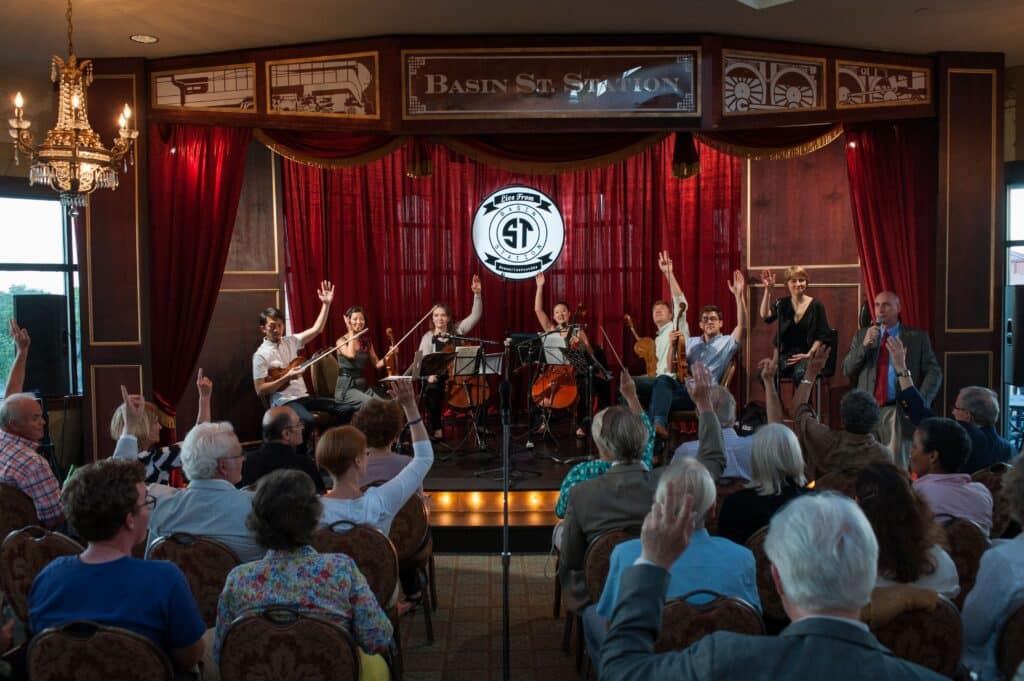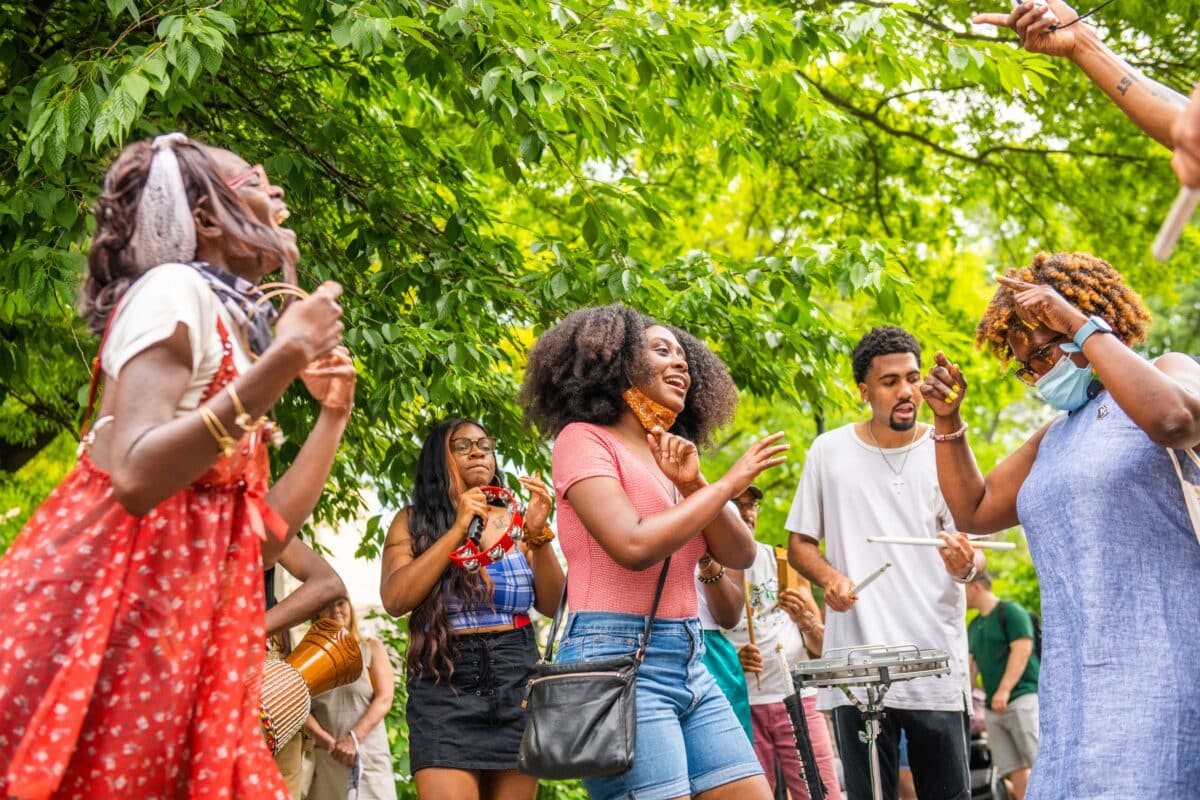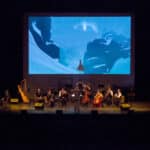Audience Engagement: Research & Resources
Learn how to grow, maintain, and diversify your audiences.

Today’s artists and presenters work harder than ever to build and maintain audiences for their performances. But new technologies, shifting demographics, and limited funding present long-term challenges for the field, especially as organizations nationwide strive toward a more equitable arts ecosystem. While there is no single, one-size-fits-all solution, there are a number of tested, data-driven strategies and tools available to help arts organizations move forward more effectively and efficiently. Through the help of our partnership with The Wallace Foundation, we’ve compiled a range of resources below. Explore videos, podcasts, and articles to learn from experts in the field; and view research reports on evolving trends, demographics, and methodologies for reaching today’s audiences.
RESEARCH
In Search of the Magic Bullet: Results from the Building Audiences for Sustainability Initiative | By Francie Ostrower, Ph.D.
- Download the report
- This report explores the results of audience-building strategies implemented by performing arts organizations.Among the key findings suggest that successful strategies meet audiences where they are, unexamined assumptions hinder an organization’s ability to connect with audiences, and targeted audience building doesn’t always equate to earned revenue growth
- Learn about the study on The Wallace Foundation’s website.
- CMA will be hosting a webinar with the author of the report, Francie Ostrower, Ph.D, on Thursday, May 2 at 3 PM ET. RSVP Here.
A Place to be Heard; a Space to Feel Held: Black Perspectives on Creativity, Trustworthiness, Welcome, and Well-Being – Findings from a Qualitative Study | By Melody Buyukozer Dawkins, Ciara K. Knight, Tanya Treptow, and Camila Guerrero
- A study of Black Americans suggests that Black communities most value arts experiences that celebrate their creativity, support self-care, earn their trust and foster a sense of belonging.
The Alchemy of High-Performing Arts Organizations, Part II: A Spotlight on Organizations of Color | By Zannie Voss and Glenn Voss
- 21 leaders of arts organizations of color report deep community engagement and high-quality programs were critical to their financial health
Millennials Are Not a Monolith: Experiences from One Group of Performing Arts Organizations’ Audience-Building Efforts | By Francie Ostrower, PhD
- Strategies to engage millennials in the arts may benefit from accounting for the group’s differences as well as its similarities, according to this brief.
The Alchemy of High-Performing Arts Organizations | By Zannie Voss and Glenn Voss
- Financial success for arts organizations begins with artistic excellence and cultural relevance, suggest interviews with leaders of 20 high-performing organizations.
Research and Self-Reflection Help Strengthen Community Ties | By Bob Harlow
- Learn how the Fleisher Art Memorial in Philadelphia was able to use research, self-reflection, and community engagement to make their organization a more inclusive space in new updates to the Foundation’s 2015 Case Study.
The Road to Results: Effective Practices for Building Arts Audiences | By Bob Harlow
- Based on case studies of 10 arts organizations that undertook audience-building projects as part of the Wallace Excellence Awards initiative, this guide pinpoints nine practices that successful efforts had in common—from identifying a target group that made sense for the organization to determining what barriers needed to be removed for that target to join the audience.
Taking Out the Guesswork: A Guide to Using Research to Build Arts Audiences | By Bob Harlow
- Cultivating new audiences and strengthening bonds with current attendees is a top priority for most arts organizations. Yet even though audience research can help achieve those goals, many arts organizations shy away from it, often citing lack of money, time, or skills to carry out the endeavor.
A Decade of Arts Engagement: Findings From the Survey of Public Participation in the Arts | The National Endowment for the Arts
- This report synthesizes findings across several modes of arts participation (attending the visual and performing arts, reading literature, creating/performing art, using digital media to consume art, and learning within the arts) to show how many American adults–and from which backgrounds–have engaged in art throughout the decade of 2002 to 2012.
- Based on the NEA’s Survey of Public Participation in the Arts (SPPA), conducted in partnership with the U.S. Census Bureau.
When Going Gets Tough: Barriers and Motivations Affecting Arts Attendance | The National Endowment for the Arts
- This report examines demographic and socio-economic characteristics of adults who attended visual and performing arts activities in 2012, but unlike prior NEA research, it offers in-depth perspectives on attitudes, motivations, and barriers concerning arts attendance. Based on an NEA module to the 2012 General Social Survey (GSS).
CMA also conducted a series of surveys on the impact of COVID-19 on the chamber music field.
View the latest summary: June 2022
VIDEOS
PODCASTS
New episodes will be released on our Soundcloud Page. Please stay tuned for future episodes and more information.
CMA Talks Season 3, Ep. 2: Close Listening
- In this episode, we speak with Melody Buyukozer Dawkins from Slover Linett Audience Research (sloverlinett.com/) on the new qualitative report, “A Place to Be Heard, A Space to Be Held: Black Perspectives on Creativity, Trustworthiness, Welcome, and Well-Being. ”The wide-ranging discussion includes background information on the creation and execution of the study as well as key takeaways for ensemble music professionals to use in their own work.
- We also listen to a selection from “Pillar III” from Andy Akiho’s Seven Pillars performed by Sandbox Percussion.
CMA Talks Season 3, Ep. 1: The Dangers of Returning to a Monochromatic Arts World
- In this episode, we hear from pianist, music educator, and researcher, Rod Vester, whose recent article in the Summer 2021 issue of Chamber Music Magazine urges ensembles and organizations not to abandon the racial equity commitments they made during 2020’s public reckoning. He talks about his personal connection to this work, highlights the importance of culture and belonging in D.E.I. initiatives, and gives tangible tips on how we can all know better, do better, and be better.
ARTICLES





Pappy’s Most Resonant Note | By Larry Blumenfeld
- Can the legacy of a bassist and activist keep jazz, and hope, alive in Buffalo?
Close Listening | By Andrew Frank
- A new qualitative study focusing on the experiences of Black Americans at arts and culture organizations offers some first steps for administrators seeking a more equitable path forward.
The Road Ahead | By Andrew Frank
- For organizations facing unprecedented financial uncertainty, a strategy built around scenario planning can help clarify the options and make hard decisions less daunting.
When Instincts Aren’t Enough | By Andrew Frank
- When seasons and tours resume, presenters and ensembles will need to work strategically to get back on their feet. Audience research can help ensure their decisions are the right ones.
The Inside Story | By Nicole Loeffler-Gladstone
- Fifth House Ensemble combines the power of storytelling with studio practice, education, and civic engagement, and builds new audiences in the process.
Turning the Tide | By Charlie Kaplan
- To reach millennial audiences, arts organizations must adapt to a new set of tastes, technologies, and spending habits. New data from the Wallace Foundation can help.
San Francisco Performances’ Creative PIVOT | By Claire Sykes
- A new series from the established Bay Area presenter uses data-driven insights to attract and keep an elusive target audience.
Understanding Your Audience | By Marla Teyolia and Dr. Zannie Voss
- Many arts organizations and ensembles have more information about their audiences than they realize, but they don’t use that data to their advantage. By using data—and collecting more—your organization may be able to make more informed decisions, plan for the future, and check its overall health.
Finding—and Keeping—Your Audience | By Ellen Goldensohn
- “What information do you lack that—if you had it—would help you make a breakthrough in audience-building?” The Wallace Foundation first asked that question of arts organization leaders in 2006. What followed was a multi-year initiative that has yielded a trove of illuminating insights into what draws people to participate in the arts—and what keeps them coming.
CMA’s Audience Engagement resources are presented with support from the Wallace Foundation. Visit the Wallace Foundation’s Knowledge Center for information on Building Audiences for the Arts.
